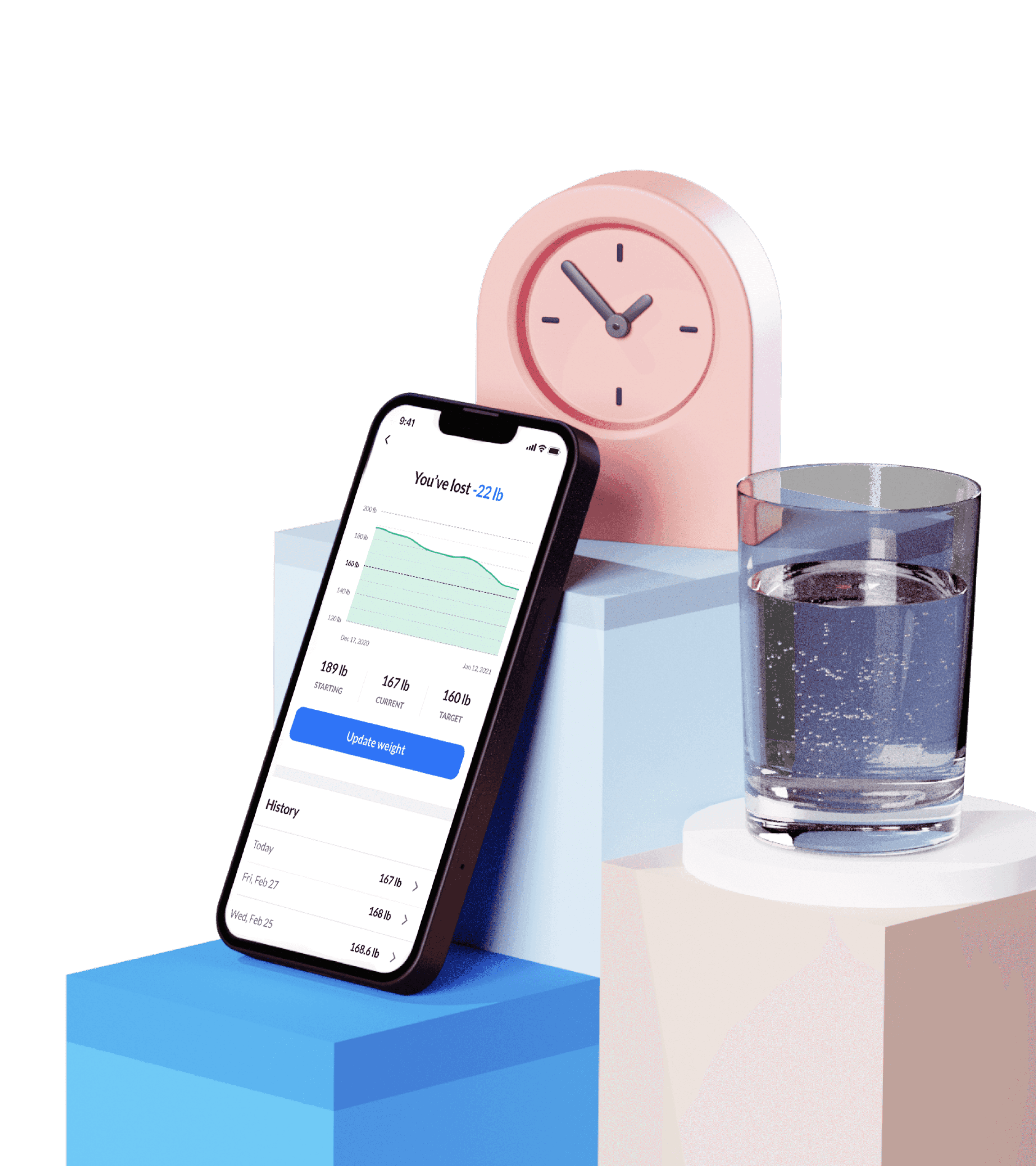Contents
What Are Macronutrients (or Macros)?
When it comes to nutrients, there are macronutrients and micronutrients. Macronutrients are essentially the nutrient types that we need in larger quantities for our bodies to function correctly.
Macronutrients include fat, carbohydrates, and protein. Each macro differs in the number of calories per gram it provides.
Take a
1-minute quiz
and discover how much weight you can lose with DoFasting!

The difference between macronutrients and micronutrients
Micronutrients are the elements of food and drink that we need in smaller quantities. These tend to include water-soluble and fat-soluble vitamins, minerals, and other plant compounds.
Micronutrients tend to come along with our macronutrients. For instance, when we drink milk we will get fat and protein as well as a dose of calcium, which is a micronutrient.
Carbohydrates
Carbohydrates are a macronutrient that comes in the form of fiber, starches, and sugars. They are essential and are turned into glucose by the body to provide it with energy.
There are many different kinds of carbohydrates and they are split into two kinds; simple carbohydrates and complex carbohydrates.
Both starches and fiber are classed as complex carbohydrates. Starches are harder for the body to break down and include beans, legumes, fruits, whole grain products, and vegetables.
Fiber is not broken down at all by the body and passes straight through the digestive system. It is found in many natural products, including fruit, vegetables, nuts and seeds, whole grains, and legumes.
Fiber is essential in the body to aid digestion, help keep you fuller for longer, regulate blood sugar, and lower cholesterol.
Sugars are simple carbohydrates that are broken down by the body quickly which leads to a blood sugar spike and then a drop. There are two kinds of sugars; those that are naturally occurring like the kind found in fruit, and those that are classed as added sugars.
Your body cannot actually tell the difference between natural sugars and added sugars and it processes them in the same way, however, natural sugars tend to come with other micronutrients (like vitamins in fruit) which is why it is better to avoid added sugar.
Food that is high in carbohydrates tends to be quite high in calories too. Carbohydrates provide around 4 calories per gram.
Fats
Dietary fat is a kind of macronutrient. It is essential in the body, but only in small amounts. Eating too many fats can be harmful to your health. Food that is high in fat is also high in calories, providing around 9 calories per gram.
There are three different kinds of dietary fats found in foods; saturated fats, unsaturated fats, and trans fats.
Unsaturated fats are usually referred to as healthy fats. They are liquid at room temperature and are better to consume than other kinds of fats.
There are two different kinds of unsaturated fats; monounsaturated fats and polyunsaturated fats.
Monounsaturated fats include olive oil, avocados, some nuts, and seeds. Polyunsaturated fats are found in sunflower oil, corn oil, flaxseed oil, flaxseeds, fish, and some nuts and seeds.
Omega-3 is a well-known polyunsaturated fat that is difficult for the body to get. Eating fish 2 – 3 times a week, or taking an omega-3 supplement can ensure you get this essential fatty acid in your diet.
Many people do not get enough unsaturated fats but they come with lots of health benefits, including reducing inflammation and promoting heart health.
Saturated fats are mostly found in animal products – notable exceptions include coconut oil and palm oil – and it is recommended that you only get 10% of your calories per day from this type of fat.
Trans fatty acids, or trans fats, tend to be found in restaurant and takeaway food and are considered the worst kind of fat. Trans fats are associated with an increased risk of heart disease and stroke.
Proteins
Protein is another kind of macronutrient that is essential in the body and is used to help build muscle. You usually find the most protein in animal products but it can be found in plant foods too.
High-protein foods tend to vary in their calorie value depending upon the kind of protein you choose but usually provide around 4 calories per gram. It is recommended that between 10 – 35% of your daily calories come from protein.
Popular sources of protein include meat, fish, eggs, soy, beans, legumes, nuts, and seeds.
How to Count Macros In 3 Steps
Whether you’ve been looking into nutrition or you’ve just overheard it at the gym, counting your macros is a good way to maintain your health and can support weight loss.
Below, we’ve provided a step-by-step guide to counting your macros.
-
Calculate how many calories you need
Before you can begin counting macros, you’re going to need to work out how many calories your body needs per day. This value is equal to your total daily energy expenditure.
To work out how many calories your body needs, you’ll need to know your basal metabolic rate (BMR). This value lets you know how many calories your body burns as it performs basic functions.
The BMR value is equivalent to your metabolism rate which is equal to around 60 – 70% of the calories we burn each day.
The formula for working out your basal metabolic rate is as follows:
Men: BMR = 66.5 + (13.75 x weight in kg) + (5.003 x height in cm) – (6.755 x age in years)
Women: BMR = 655.1 + (9.563 x weight in kg) + (1.85 x height in cm) – (4.676 x age in years)
This number does not factor in your activity level. To do that, you need to apply the Harris-Benedict formula. This formula multiplies your BMR by a figure reflective of your activity levels. These figures are as follows:
Little to no exercise = 1.2
Light exercise = 1.375
Moderate exercise (3 – 5 days a week) = 1.55
Very active (6 – 7 days a week) = 1.725
Extra active (very active + physical job) = 1.9
To work out the number of calories that your body needs to maintain your current weight, the formula is as follows:
Calories = activity value x BMR value
This figure is indicative of your total daily energy expenditure.
Counting example
Calorie example for a woman:
655.1 + (9.563 x 77) + (1.85 x 150) – (4.676 x 25) = 1552.051
BMR = 1552.051
1552.051 x 1.55 (moderate exercise) = 2405.67
Calories = 2406
Note: calories can be subtracted from this amount for those trying to lose weight. To lose weight you need to eat at a calorie deficit.
-
Calculate your ideal macro ratio
Average macro recommendations are as follows:
Carbs: 45 – 65% of your total caloric intake per day
Fats: 20 – 35% of your total caloric intake per day
Protein: 10 – 35% of your total caloric intake per day
These recommendations may not fit your specific needs though. Some conditions and specific diets require a different macro ratio.
For example, those following a keto diet will need to eat much fewer carbohydrates and plenty more fats than is recommended in this model to achieve the high-fat low-carb ratio needed for ketosis.
You could try using a macro calculator to work out your perfect ratio.
-
Start tracking your macros and calorie intake
Counting macros essentially means logging the food you eat in an app, on a website, or in a notebook. You may need to invest in a food scale to keep your tracking 100% accurate, though it is not essential.
We recommend using an app, like the DoFasting app, to track your macros. It is user-friendly and calculates your macronutrient intake from the foods that you log daily. It also keeps track of your caloric intake and your overall progress.
Take a
1-minute quiz
and discover how much weight you can lose with DoFasting!

The Difference Between Counting Macros and Counting Calories
When it comes to weight loss, you will frequently hear people speak about tracking calories, and while it sounds like macro counting, it is not the same thing.
A calorie goal limits you to eating a certain amount of calories each day. You must stay within this limit but what you eat within this limit does not matter.
With macro counting, you are assigned a specific amount of each macro to eat each day and so your food consumption is more defined.
4 Main Benefits of Counting Macros
Counting macros is a popular method for weight loss and overall health. It comes with many benefits including helping you to make healthier food choices, helping you to reach your diet goals, helping you to trim excess body fat, and helping you achieve specific goals.
Take a look below to find out more about each benefit.
-
It helps you make healthier food choices
Paying more attention to your macros can help you to understand which foods are better for your body. While a limited daily calorie intake can help you to lose weight, you may not eat better because of it.
Counting your macros means choosing foods because of their macronutrient value, instead of their caloric value. For instance, a bowl of fries may have the same caloric value as a plate full of vegetables and whole grains, but the vegetables and whole grains are much better for your body.
By understanding the macronutrients we put into our bodies and what they can do for us, we can make better choices about the food we eat and remain in optimal health.
-
It can help you reach your diet goals
Counting macros also means being able to reduce and increase your intake of certain macros to slim down. You can adjust your intake to lose fat, increase muscle gain, and reduce overall body weight, depending on your ratio.
Unlike when you choose to count calories, a macro diet allows for more flexibility about what you put into your body meaning you can eat for specific diet goals.
-
It may help you slim down
Tracking food is thought to be an effective method of weight loss. By logging each of the foods you eat and when you eat them, you know when you have hit your goals for the day and you can limit the amount you consume to create a calorie deficit.
As a calorie deficit is essential for weight loss, eating fewer calories than you burn is crucial. Counting macros for weight loss means only consuming the food your body actually needs.
-
It can help you with specific goals
Certain diets call for certain macro compositions. The keto diet, for example, calls for a low-carb, high-fat diet with the aim of pushing the body into the fat-burning metabolic state of ketosis.
The keto diet aims to help you lose body fat and counting your macros is a really easy way of maintaining this kind of diet.
You may also choose to count your macros if you are looking to increase your muscle mass. Muscle gain requires much more protein than the average daily recommended values and so you can adjust your macro intake to suit this goal too.
So, whether you’re looking to lose fat, increase lean body mass and muscle mass, or just stay the same weight, counting your macros provides the kind of flexible dieting you will need.
Meet Your Daily Needs With Foods High in Macros
If you’re considering beginning counting your macros, you might be a little nervous as you wonder where each of the macros you need come from. Below, we have rounded up some of the best foods to consume to hit each of the three macros each day.
High-carb foods
To hit your carbohydrate daily value, try adding these healthy foods to your diet:
- Grains, like quinoa, oats, and buckwheat
- Fruits like oranges, blueberries, grapefruit, apples, and bananas
- Starchy vegetables, like sweet potatoes and butternut squash
- Beans, like kidney beans, butter beans, and chickpeas
High-protein foods
When it comes to protein, you can get it from both animal products and plant sources.
For those who eat animal products, great sources of protein include:
- Eggs
- Dairy products, including cottage cheese, Greek yogurt, milk
- Poultry like chicken breast, turkey breast
- Red meat, including lean beef (but eaten in moderation)
- Fish, including salmon and herring (both great sources of omega-3)
For a plant-based high protein intake:
- Lentils
- Nuts, like almonds, walnuts, pistachios, and cashews
- Seeds, including pumpkin seeds and flaxseeds
- Beans and legumes, like soybeans, pinto beans, and kidney beans
- Tofu
High-fat foods
To increase your fat intake, add these healthy options to your diet:
- Avocadoes
- Eggs
- Fatty fish
- Nuts
- Chia seeds
- Extra-virgin olive oil
Remember that fat should be eaten in moderation as too much can be bad for your health. Always opt for unsaturated healthy fats when it is possible.
5 Common Macros Tracking Mistakes and How to Avoid Them
Macro counting, like many diets, comes with some common mistakes. We’ve summarized each below to help you avoid it when you begin your macro diet.
-
Measuring food by volume instead of weight
Measuring by volume refers to measuring your food by the amount you can fit on a spoon or in a cup. This can vary greatly depending on the kind of food you are measuring and so is an inaccurate measurement.
When counting macros, it is always best to measure using the food weight to get the most accurate value. Though it is not essential, you may want to invest in a food scale when counting macros so you can accurately log how many grams of each you’re eating.
-
Eating small bites too often without recording them
We’re all guilty of nibbling on a biscuit here and there, but if you do this often and don’t track it in your macros for the day, you may find that you don’t achieve your weight loss or diet goals.
This is because every single thing you eat is digested and used by your body. If you are eating small amounts of sugar or fat here and there and not tracking it, then your macro value for that day will not be accurate.
To avoid snacking and nibbling, ensure you eat enough at each meal to stay full, and make sure to log any snacks you have.
-
Forgetting to record cooking oils
Cooking oils actually contain a lot of fat and calories, indeed cooking oils can have up to 9 calories per gram. Though most of them contain unsaturated, and therefore healthy fats, they still need to be added to your daily macros.
Remember to add whatever you cook your food in, into your log to get the most accurate values.
-
Eating hard-to-track foods too often
Some foods can be harder to track than others. Many apps now allow you to scan product barcodes, which makes tracking much easier, but if you’re eating out often or getting lots of takeaways, you’re going to be estimating a lot of your values.
Try to eat more home cooked meals where you can measure your ingredients for the most accurate macro values each day.
-
Not get help for tracking macros
If you’re struggling to track your macros accurately, then get some help! An easy way to do this is to find a food tracking app or a macro tracking app.
Try out the DoFasting intermittent fasting app that provides you with an easy way to track your macros, calories, and progress to keep you motivated and on track. It can also provide you with easy-to-cook recipes for when you need some food inspiration.
Take a
1-minute quiz
and discover how much weight you can lose with DoFasting!

Conclusion
Tracking your macros is an effective way to reduce your body weight and achieve
your dieting goals. Many people choose to count macros over a calorie goal because it
provides a more accurate picture of what you’re eating, helping you to make
healthier choices.
Counting your macros is also good for flexibility when it comes to your diet. You can cater your diet to specific goals, so whether your aim is losing fat or you want to gain muscle mass, you can adjust your diet to achieve these goals.
Check out our top tips and tricks for how to track macros now to start this method of dieting.
Leave a Reply
See how DoFasting will improve your life
Find out what works for you with this 60-sec quiz approved by our experts and get your personal revolutionary fasting assistant.
Start the Quiz















2 Comments
Hurrah! At last I got a web site from where I be capable
of actually take valuable information regarding my study and knowledge.
We are glad you found it useful!